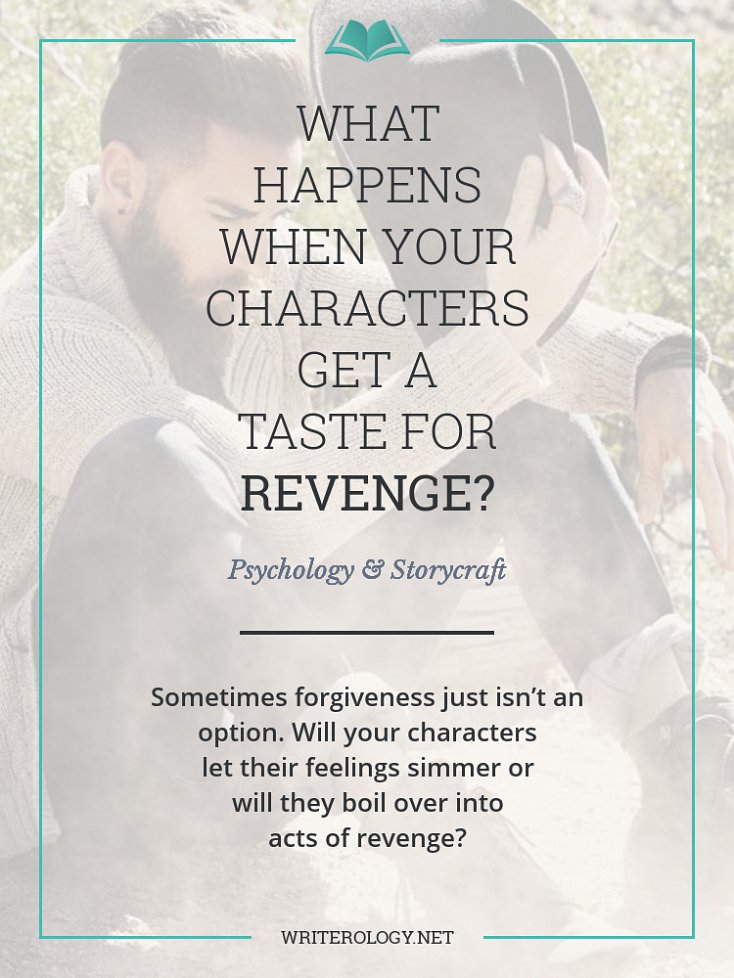What Happens When Characters Get a Taste For Revenge?
Sometimes forgiveness just isn’t an option. Will your characters let their feelings simmer... or will they boil over into acts of revenge? (Oh, you diabolical writer, you.)
When we’ve been hurt, we can choose to forgive... or we can get even.
Previously, we’ve looked at the benevolent side of our characters and their paths of forgiveness. This post takes a darker turn. Let’s see how and why characters choose to get their own back.

People seek revenge to restore fairness and balance to a relationship after they’ve been hurt by someone. However, what the avenger sees as justifiable and even-handed is often seen as excessive to the original wrongdoer.
That creates a problem: now the punished wrongdoer feels wronged themselves and might seek their own vengeance. Before you know it, you have an escalating cycle of revenge.
The Process of Revenge
Naming
This is the stage of the revenge process in which you, as the victim, believe something harmful has been done to you by someone else. The offender could have broken a rule or hurt your self-concept (how you think about yourself), which in turn might trigger the need to reassert or reclaim your self-concept through vengeful actions.
Blaming
At this point, you ‘blame’ someone for the harm you’ve suffered and place the responsibility for it squarely on the offender’s shoulders. More blame is heaped on the offender if he willingly carried out the behaviour and wanted its negative effects to pan out.
Claiming
During the final stage of the revenge process, you want to ‘claim’ recompense from the wrongdoer. Anger is one of the primary emotions in Western culture that triggers this need for exacting vengeance, whereas shame is a primary motivator in Eastern cultures.
What Makes Revenge Sweet?
The Comparative Suffering Hypothesis
According to this hypothesis, you get satisfaction from revenge when the offender suffers an acceptable amount of pain or loss. The offender could suffer at your hands or the hands of fate and misfortune; either way, as long as he experiences some kind of harm himself, you can gain a sense of satisfaction.
The Understanding Hypothesis
In this hypothesis, you seek revenge to deliver a message: ‘This is a punishment for what you’ve done’. You gain satisfaction only if the offender understands that message. If he doesn’t realise he’s being punished or doesn’t know why he is, then you are robbed of satisfaction.
The Understanding Hypothesis tends to get more support when tested, which suggests that revenge isn’t just about payback, but about hammering home a message.
Applying Theory to Fiction
Characters
If you’re creating a character who is more likely to seek revenge, take a closer look at the Understanding Hypothesis. Revenge is exacted to deliver a message. That message might be along the lines of: ‘You’re being punished because you tried to walk over me and I won’t take it.’ Having a character who isn’t passive can lead to less inhibited vengeful actions.
Consider your characters’ cultures when deciding what their primary motivating emotion is for revenge. For example, those from Eastern cultures are more likely to seek revenge due to shame than due to anger.
Conflict
The three stages of the revenge process can help you to plan out the progression of your character’s pursuit of retribution.
You can use the two hypotheses above to dictate whether or not your character feels satisfied by her vengeful actions. If she merely caused the offender pain, without conveying a message, she might not feel satisfied in her revenge—which could lead to further vengeful acts to try to attain that feeling.
The cycle of revenge, which can result from the offender feeling excessively wronged and seeking retribution of his own, can lead to an escalation of revenge and, therefore, of conflict. Imagine two characters continually trying to get their own back on the other, with each act becoming more and more harmful and dangerous...